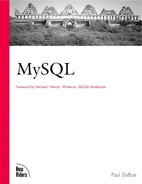Appendix I. Useful Third-Party Tools
This appendix gives you a brief, illustrative overview of the types of third-party tools available to help you use MySQL more easily and effectively. A more comprehensive, frequently updated list of software is available at the MySQL Web site. My goal here is simply to make you aware of some of the types of tools available and to encourage you to take a look at some of them for yourself. See http://www.mysql.com/Contrib/ for more information. You'll find many different packages that can help you. These come in several categories:
Language APIs and programming tools. MySQL is well-representedby programming interfaces. In addition to the Perl and PHP interfaces that were discussed in Chapters 7, "The Perl DBI API," and 8, "The PHP API," interfaces for several other languages are available. These include C++, Delphi, Eiffel, Guile, Java, Matlab, Pike, Python, Ruby, Smalltalk, and Tcl. There are also wrapper libraries, such as a C library that presents a Visual Basic-style interface to the host program.
Other tools are available that help you use the APIs. You can take output produced by mysqldump that describes table structures and convert it into a C header file. This is useful for writing C programs that use the MySQL C API to access the table. If you use Tcl/Tk, an interface screen generator is available.
Packages that extend MySQL's capabilities. These include tools to provide full text searching and tools that help you replicate MySQL databases.
Data conversion tools. These include programs that make it easier to convert data used in other programs for use with MySQL, and vice versa. For example, you can convert between .dbf files and MySQL tables, or between Access tables and MySQL tables.
ODBC support. TheODBC (Open Database Connectivity) standard developed by Microsoft allows ODBC-compliant programs to access MySQL databases if a MySQL driver is available. For example, you can install MyODBC on Windows and then use ODBC programs under Windows to access MySQL. One common application involving MyODBC is to connect to a MySQL server from Microsoft Access. To do this, you must have MyODBC set up under Windows, and you should have created a data source name (DSN) for connecting to MySQL. (If you haven't set up MyODBC or created a DSN, see Appendix A, "Obtaining and Installing Software.") After ODBC has been set up, use the following procedure to connect to the MySQL server from within Access:
Start the Access program.
Create a new empty database.
From the File menu, select "External Data," then "Link Tables."
In the window that appears, click on the "Files of type" popup menu and select "ODBC Databases."
Select the DSN that you specified in the ODBC Control Panel for connecting to MySQL.
Start linking.
Select the tables you wish to see.
Interfaces to other programs. Several tools have been written to help you incorporate MySQL as the back end for other programs.There are patches for Apache and WU-ftpd to make these programs perform logging into MySQL tables. You can use MySQL to perform mail user authentication for qmail and the Cyrus IMAP server. pam authentication can be done using MySQL as well.
Administrative tools. Programs to make it easier to manage your MySQL installation come in several different forms. Some are command-line programs, and several others are GUI tools. Some graphical clients are based on the X Windows System, another runs under Windows, and still others, written in Perl and PHP, are Web-based.
